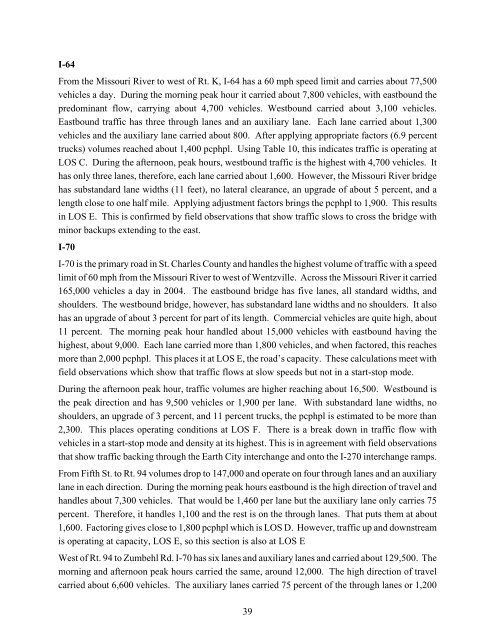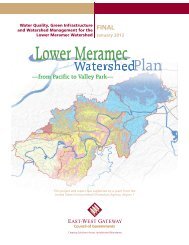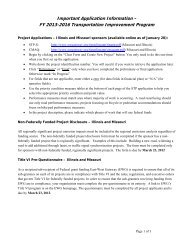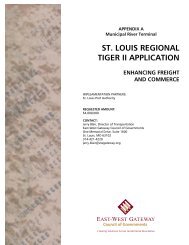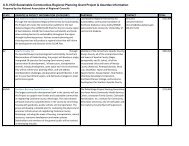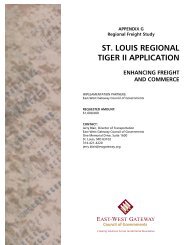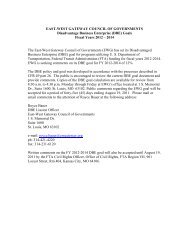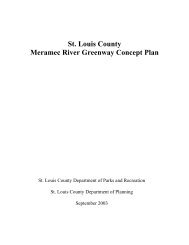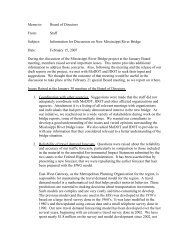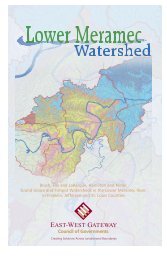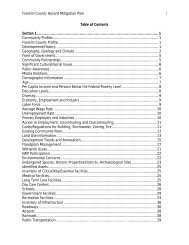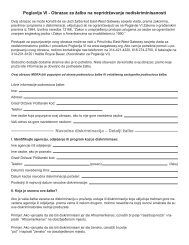St. Charles County Transportation Plan 2030 - East-West Gateway ...
St. Charles County Transportation Plan 2030 - East-West Gateway ...
St. Charles County Transportation Plan 2030 - East-West Gateway ...
Create successful ePaper yourself
Turn your PDF publications into a flip-book with our unique Google optimized e-Paper software.
I-64<br />
From the Missouri River to west of Rt. K, I-64 has a 60 mph speed limit and carries about 77,500<br />
vehicles a day. During the morning peak hour it carried about 7,800 vehicles, with eastbound the<br />
predominant flow, carrying about 4,700 vehicles. <strong>West</strong>bound carried about 3,100 vehicles.<br />
<strong>East</strong>bound traffic has three through lanes and an auxiliary lane. Each lane carried about 1,300<br />
vehicles and the auxiliary lane carried about 800. After applying appropriate factors (6.9 percent<br />
trucks) volumes reached about 1,400 pcphpl. Using Table 10, this indicates traffic is operating at<br />
LOS C. During the afternoon, peak hours, westbound traffic is the highest with 4,700 vehicles. It<br />
has only three lanes, therefore, each lane carried about 1,600. However, the Missouri River bridge<br />
has substandard lane widths (11 feet), no lateral clearance, an upgrade of about 5 percent, and a<br />
length close to one half mile. Applying adjustment factors brings the pcphpl to 1,900. This results<br />
in LOS E. This is confirmed by field observations that show traffic slows to cross the bridge with<br />
minor backups extending to the east.<br />
I-70<br />
I-70 is the primary road in <strong>St</strong>. <strong>Charles</strong> <strong>County</strong> and handles the highest volume of traffic with a speed<br />
limit of 60 mph from the Missouri River to west of Wentzville. Across the Missouri River it carried<br />
165,000 vehicles a day in 2004. The eastbound bridge has five lanes, all standard widths, and<br />
shoulders. The westbound bridge, however, has substandard lane widths and no shoulders. It also<br />
has an upgrade of about 3 percent for part of its length. Commercial vehicles are quite high, about<br />
11 percent. The morning peak hour handled about 15,000 vehicles with eastbound having the<br />
highest, about 9,000. Each lane carried more than 1,800 vehicles, and when factored, this reaches<br />
more than 2,000 pcphpl. This places it at LOS E, the road’s capacity. These calculations meet with<br />
field observations which show that traffic flows at slow speeds but not in a start-stop mode.<br />
During the afternoon peak hour, traffic volumes are higher reaching about 16,500. <strong>West</strong>bound is<br />
the peak direction and has 9,500 vehicles or 1,900 per lane. With substandard lane widths, no<br />
shoulders, an upgrade of 3 percent, and 11 percent trucks, the pcphpl is estimated to be more than<br />
2,300. This places operating conditions at LOS F. There is a break down in traffic flow with<br />
vehicles in a start-stop mode and density at its highest. This is in agreement with field observations<br />
that show traffic backing through the Earth City interchange and onto the I-270 interchange ramps.<br />
From Fifth <strong>St</strong>. to Rt. 94 volumes drop to 147,000 and operate on four through lanes and an auxiliary<br />
lane in each direction. During the morning peak hours eastbound is the high direction of travel and<br />
handles about 7,300 vehicles. That would be 1,460 per lane but the auxiliary lane only carries 75<br />
percent. Therefore, it handles 1,100 and the rest is on the through lanes. That puts them at about<br />
1,600. Factoring gives close to 1,800 pcphpl which is LOS D. However, traffic up and downstream<br />
is operating at capacity, LOS E, so this section is also at LOS E<br />
<strong>West</strong> of Rt. 94 to Zumbehl Rd. I-70 has six lanes and auxiliary lanes and carried about 129,500. The<br />
morning and afternoon peak hours carried the same, around 12,000. The high direction of travel<br />
carried about 6,600 vehicles. The auxiliary lanes carried 75 percent of the through lanes or 1,200<br />
39


